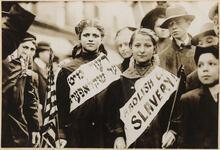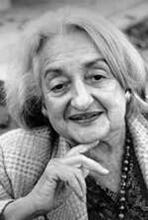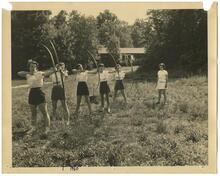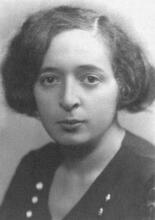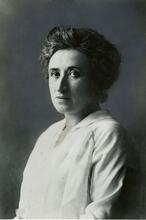Helene Khatskels
Portrait of Helene Khatskels, ca. 1920. Source: Leksikon fun der yidisher literatur, prese, un filologye, edited by Zalman Reisen (Vilna: 1927), 35. Via Wikimedia Commons.
Helene Khatskels occupied many groundbreaking roles during her life. Growing up in a city known for its centrality to the dissemination of socialist beliefs and the organization of the Jewish labor movement, studying at Russia’s first, highly political institution of higher education for women, Khatskels became involved with the General Jewish Workers’ Bund. After the first failed Russian Revolution of 1905, when the Bund’s focus shifted from inspiring socialist revolution to promoting Yiddish culture, Khatskels became involved in that, too. She became a leading figure of the Yiddishist school movement and was key to creating some of the first Yiddish curricula. In the Soviet Union, Khatskels continued to advocate for Yiddish cultural autonomy as she turned to writing travelogues and translating works into Yiddish for children.
In its commitment to socialism, Lit. (Greek) "dispersion." The Jewish community, and its areas of residence, outside Erez Israel.diaspora Jewish nationalism, and Yiddish secular education, the life of the Yiddish pedagogue and writer Helene Khatskels closely reflects the history and ideals of the Jewish Labor Bund, which she actively supported. Her unfaltering devotion to her pupils, evident from both her own writings and writings about her, makes her stand out in the charged atmosphere of East European Jewish politics in the early twentieth century.
Education and Early Involvement with the Jewish Labor Bund
Khatskels was born on July 25, 1882, in Kovno (Kaunas) in the Russian Empire. A baker’s daughter, she attended the gymnasium in Kovno and went on to study history at the Bestuzhev Higher Women’s Courses in St. Petersburg. Khatskels’s encounter with revolutionary socialist ideas may date back to her upbringing in Kovno, a city that played a key role in the organization of the Jewish labor movement and the smuggling of illegal socialist literature into Tsarist Russia. However, her studies at the first higher education institution for women in Russia, with its highly politicized student body, undoubtedly sharpened her political sensibilities; and upon her return to Kovno in 1904, Khatskels joined the local committee of the Jewish Labor Bund. As an active Bundist, Khatskels, under the code name “Rachel,” was involved in book smuggling and other clandestine activities, which took her to various cities in the Pale of Settlement and led to her arrest by the Tsarist authorities.
After the failed 1905 Russian revolution and the ensuing reaction, the focus of Bundist activities shifted towards Yiddish cultural work. Khatskels’s biography mirrors this shift in that, after 1905, she started working as a teacher in Vilna (Vilnius), becoming increasingly devoted to the aim of establishing secular Yiddish schools. She maintained her close ties with the Bund and worked as one of the local organizers of the Bundist movement at St. Petersburg University, where she went to study natural science in 1915.
Spreading Yiddish Culture in Schools
Khatskels’s first steps as a teacher took place in the Russian-Jewish elementary schools, which had been established so that the government authorities could exercise control over Jewish education. In the aftermath of the 1905 revolution, when, paradoxically, it became easier to set up private Jewish secondary schools, Khatskels took up work as a history teacher at the Sophia Gurevitch gymnasium in Vilna.
It was in this period that secular Jewish schools that used Yiddish as the language of instruction first developed. Their number rose significantly during the German occupation of Lithuania (1915–1918) in World War I, when the Germans, in their aim to counteract all Russian influence, promoted the use of the children’s mother tongue as the language of instruction. In 1916, Khatskels, having returned to Vilna from her studies in St. Petersburg, took up the principalship of a Yiddish middle school for girls.
One difficulty faced by the emerging Yiddish school network was the shortage of Yiddish textbooks, and Khatskels, a faculty member of the Yiddish teacher training college in Vilna, made a significant contribution to Yiddish pedagogy by publishing the first curriculum for the study of natural science and geography (Vilna, 1918).
Work After the Russian Revolution
In 1918, Khatskels left Vilna and moved to Moscow to learn about the new Soviet educational system. She returned two years later to her hometown of Kovno—by now the capital of independent Lithuania. In the new Lithuanian republic, Jewish cultural autonomy made it possible to establish Jewish schools teaching in Yiddish. Khatskels threw herself at the task at hand and became a leading figure in the Yiddishist school movement and in the Lithuanian Kultur-Lige (League for Culture), which was founded in 1919 to promote Yiddish culture and to serve as an umbrella organization for the emerging Yiddish schools. Khatskels helped set up the Kultur-Lige’s Yiddish teacher training courses in Kovno and worked as lecturer for natural science and history.
However, all efforts notwithstanding, the Yiddish schools in Lithuania, and especially in Kovno, never became the main education system, as secular and religious Hebrew school networks attracted the majority of students. The situation worsened when, in 1921, the Kultur-Lige came entirely under Communist influence, which prompted many parents to take their children out of the Yiddish schools. The American journalist, B. Z. Goldberg (1895–1972), describing his visit to a Yiddish elementary school in Kovno at the end of 1921, commented on how the grinding poverty in the school was offset by the idealism and dedication of the teacher, “the well-known educator Helene Khatskels,” who urged him to raise money for a school clock when back in America.
Jewish cultural autonomy in Lithuania ended in 1924. The Kultur-Lige and its schools were closed, and Khatskels was temporarily arrested. After her release, she co-founded a Communist cover organization, the so-called Gezelshaft oyftsuhaltn dem fizishn un psikhishn tsushtand fun yidishn kind (Society for the support of the physical and mental well-being of the Jewish child).
Translation and Travelogues as an Outlet for Cultural Expression
It was at the end of the 1920s that Khatskels flourished as a writer. Having previously published a number of elementary school textbooks on natural science and geography, she became a prolific contributor to the children’s magazines Grininke beymelekh (Little Green Trees, Vilna) and Der khaver (The Friend, Vilna), writing travel and popular science pieces as well as translating a number of children’s classics such as Frances Hodgson Burnett’s Little Lord Fauntleroy, George Sand’s Wings of Courage, and Lucy Fitch Perkins’s twins series. Khatskels’s travelogues and translations show her knowledge of languages and long-standing fondness of travel, but also her desire to foster an interest and understanding of other cultures amongst her young readership.
While even Khatskels’s writing for children leaves little doubt as to her Communist allegiance, there is ample evidence for her willingness to work across ideological divides. Not only was she the long-time editor of the children’s supplement of the Folkist-oriented newspaper, Folksblat (1931–1939), but she also served as an adviser and, in 1929, visited the Zionist youth village in Ben Shemen, whose first residents were children from the Jewish orphanage in Kovno.
After the Soviet annexation of Lithuania in 1940, Khatskels traveled to Moscow to advocate and plan for a revived Yiddish school system in Lithuania. She spent the war years in Central Asia and returned to Kovno in early 1945, becoming the director of the kindergarten in the newly founded Yiddish school and orphanage. In 1946, she was awarded the Order of Lenin, and in 1947, the title of “Honored Teacher of the Lithuanian Soviet Republic.” In 1950, Khatskels’s school, the last Yiddish school to exist in the Soviet Union, was closed, and she continued the rest of her teaching career in Lithuanian schools. She also continued to publish educational papers as well as travelogues for children until her old age—albeit in Lithuanian rather than Yiddish. She died on January 26, 1973, in Kovno.
Selected Works
Pedagogy
Program fun naturvisnshaft mit metodishe onvayzungen; program fun geografye mit metodishe onvayzungen (Natural Science Curriculum with Methodological Instructions; Geography Curriculum with Methodological Instructions). Vilna: Vilner Yidisher lerer-gezelshaft, 1918.
Di natur arum undz: a lernbukh far folkshuln mit nakhvort tsu di lerer (Nature Around Us: A Textbook for Elementary Schools with an Epilogue for Teachers). Berlin: Wostok, 1922.
Der nayer alef-beys (The New Alphabet). Moscow: 1948.
Travelogues
Araber (Arabs). Vilna: Naye Yidishe folksshul, 1931.
In Erets-Yisroel (In Palestine). Vilna: Naye Yidishe folksshul, 1931.
A zumer in Amerike (A Summer in America). Vilna: Naye Yidishe folksshul, 1931.
A rayze keyn England (A Journey to England). Vilna: Naye Yidishe folksshul, 1931.
Finland (Finland). Vilna: Naye Yidishe folksshul, 1931.
Fun Oslo biz Bergen: a rayze iber Norvegye (From Oslo to Bergen: Travels across Norway). Vilna: Naye Yidish folkssul, 1931.
Travelogues in Lithuanian
Kelionė j Maskvą (A Journey to Moscow). Kaunas: 1947.
Vasaros kelionės (Summer Travels). Vilnius: 1956.
Birutė Kaukaze (Birutė in the Caucasus). Vilnius: 1962.
Translations
Di kleyne holender (The Little Dutchmen). Translation of Lucy Fitch Perkins, The Dutch Twins (Boston: Constable & Co., 1911). Vilna: Naye Yidishe shul, 1938.
Di fliglen fun mut (Wings of Courage). Translation of George Sand, Les ailes du courage, from Contes d’une grand-mère (Paris: Michel-Lévy frères, 1873). Vilna: Naye Yidishe shul, 1939.
Der kleyner lord (The Little Lord). Translation of Frances Hodgson Burnett, Little Lord Fauntleroy (London: F. Warne: 1886). Vilna: Naye Yidishe shul, 1940.
Abramowicz, Hirsz. Profiles of a Lost World: Memoirs of East European Jewish Life before World War II. Edited by Dina Abramowicz and Jeffrey Shandler. Translated from the Yiddish by Eva Zeitlin Dobkin. Detroit: 1999.
Branover, Herman, ed. Rossiiskaia evreiskaia entsiklopediia (Encyclopedia of Russian Jewry). Moscow: 1994.
Charney, Daniel. “Iber hundert shrayber fun Kovner Lite (More than One Hundred Writers in the Independent Lithuania).” In Lite, edited by Chaim Leikowicz, Vol. 2, 401–418. New York: 1951.
Fuks, Chaim Leib. “Khatskeles, Helene.” In Leksikon fun der nayer yidisher literatur (Biographical Dictionary of Modern Yiddish Literature), edited by Samuel Niger and Jacob Shatsky, 4:378–380. New York: 1956–1981.
Goldberg, B. Z. “Dray mol Lite (Three Times in Lithuania).” In Lite, edited by Mendel Sudarsky, Uriah Katzenelenbogen and J. Kissin, Vol. 1, 1269–1278. New York: 1951.
Hillyar, Anna, and Jane McDermid. Revolutionary Women in Russia, 1870–1917: A Study in Collective Biography. Manchester: 2000.
Kagan, Berl, ed. Leksikon fun Yidish-Shraybers (Biographical Dictionary of Yiddish Writers). New York: 1986.
Leikowicz, Chaim, ed. Lite (Lithuania). Vol. 2. New York: 1951.
Levin, Dov. The Litvaks: A Short History of the Jews in Lithuania. Jerusalem: 2000.
Ran, Leyzer. Yerushalayim d’Lite (Jerusalem of Lithuania). 3 vols. New York: 1974.
Reisen, Zalmen. Leksikon fun der yidisher literatur, prese un filologye (Biographical Dictionary of Yiddish Literature, Press and Philology), 2nd revised edition. Vilnius: 1927. Ran has a group photograph which includes Khatskels, c. 1917 in Vol. 2:327. Reisen, Vol. 2:35–36, also supplies a photograph.
Rozental-Shnayderman, Esther. “Chatzkels, Helene.” In Encyclopaedia Judaica, 5:366. Jerusalem: 1971–1972.
Savage, Leon. “Siluetn fun amoliker Kovner inteligents (Silhouettes of the Past Inteligentsia of Kaunas).” In Lite, edited by Mendel Sudarsky et al. Vol. 1, 1773–1783. New York: 1951.
Shnayderman, Sh. L. “Grusn fun yidishe shrayber in Rige un Kovne (Greetings
from Yiddish writers in Riga and Kaunas).” Forverts
(Forward), December 2, 1959.
The article considers the state of Yiddish culture in the Soviet Union in
the aftermath of Stalin’s anti-Jewish purges and includes brief notes on the
post-war biographies of Khatskels and Mark Razumny (Riga).
Shulman, Elias. “Di yidish-veltlekhe shuln in Lite (The Secular Yiddish Schools
in Lithuania).” In Leikowicz, Lite,
323–350.
The article provides an overview of the development of the various Jewish
autonomous schools in Lithuania in the interwar years and makes reference
to Khatskels as the author of highly regarded and popular natural science
textbooks in Yiddish (340).
Sudarsky, Mendel, Uriah Katzenelenbogen, and J. Kissin, eds. Lite (Lithuania). Vol. 1. New York: 1951.




